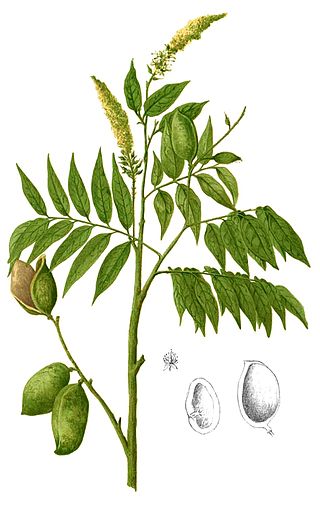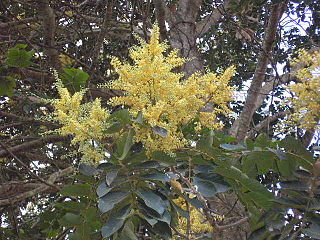
Melastomataceae is a family of dicotyledonous flowering plants found mostly in the tropics comprising c. 175 genera and c. 5115 known species. Melastomes are annual or perennial herbs, shrubs, or small trees.

Paullinia is a genus of flowering shrubs, small trees and lianas in the soapberry family, Sapindaceae and typical of tribe Paullinieae. It is native to tropical South America, Central America and the Caribbean.

Trigoniaceae is a family of flowering plants, consisting of 28 species in five genera. It is a tropical family found in Madagascar, Southeast Asia, Central and South America.

Cleome is a genus of flowering plants in the family Cleomaceae, commonly known as spider flowers, spider plants, spider weeds, or bee plants. Previously, it had been placed in the family Capparaceae, until DNA studies found the Cleomaceae genera to be more closely related to the Brassicaceae than the Capparaceae. Cleome and clammyweed can sometimes be confused.

Protium is a genus of more than 140 species of flowering plants in the family Burseraceae. It is native to the Neotropics from northern Mexico to Paraguay and southern Brazil, and to Madagascar, the Indian subcontinent, Indochina, southern China, the Philippines, Java, and New Guinea. The genus had been included in Bursera, but is distinct.

Crudia is a genus of plants in the family Fabaceae.

Macrolobium is a legume genus in the subfamily Detarioideae. It is a tropical genus with about 80 species. Half occur in Brazil, where they are common in the floodplains of the Amazonian Basin. Members of the genus are used as ornamentals and for their wood.

Tachigali is a flowering plant genus in the legume family (Fabaceae). It includes 74 species of trees native to the tropical Americas, ranging from Nicaragua to Bolivia, Paraguay, and southern Brazil. Typical habitats include tropical rain forest, lower montane forest, seasonally-flooded and non-flooded evergreen lowland forest and woodland, gallery and riparian forest, sometimes on white sands, cerrado and other dry woodland, and rocky grassland.

Monotagma is a genus of plant in family Marantaceae described as a genus in 1902. It is native to tropical America.

Parinari is a genus of plant in the family Chrysobalanaceae.

Picramnia, the bitterbushes, is a genus of flowering plants generally placed in the family Picramniaceae, but sometimes included in Simaroubaceae. The name is conserved against the genera Pseudo-brasiliumAdans., and TaririAubl., both which have been rejected.

Tapura is a genus of plant in the family Dichapetalaceae.

Voyria, commonly known as ghostplants, is a genus of 20 species of herbaceous perennial plants, belonging to the family Gentianaceae. They are mostly native to warm temperate and tropical regions of the Caribbean, Central America and South America, except for V. primuloides, which is found in West and Central Africa. V. parasitica reaches as far north as the Everglades in Florida.

Duguetia is a genus of trees and shrubs in the plant family Annonaceae with approximately 90 species in central and South America, and four species in west Africa.

Spigelia is a genus of flowering plants in the family Loganiaceae. It contains around 60 species, distributed over the warmer parts of the Americas, from the latitude of Buenos Aires to the Southern United States. It was named after Adriaan van den Spiegel by Carl Linnaeus in his 1753 Species Plantarum; the type species is Spigelia anthelmia. Pinkroot is a common name for plants in this genus.

Schnella is a genus of flowering plants in the legume family, Fabaceae. It belongs to the subfamily Cercidoideae. All of its species are neotropical lianas.

Schultesia is a genus of flowering plants in the family Gentianaceae. It includes 16 species native to the tropical Americas, ranging from Mexico and the Caribbean to northeastern Argentina, and to west tropical Africa from Senegal to Sierra Leone and Chad.

















